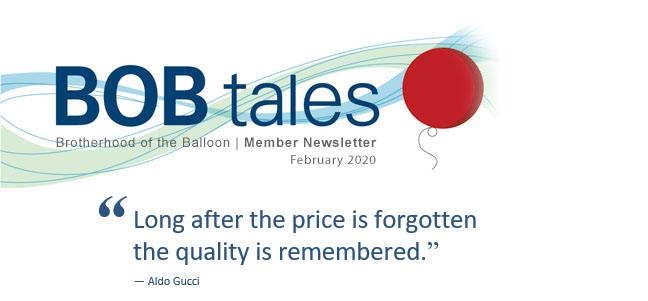
Dear Members (a note from Bob Marckini):
There’s much to write about this month, including an update on the proposed Medicare alternative payment model for radiation oncology, a new study showing the benefits of proton therapy, dramatic improvements in prostate imaging and cancer diagnosis, another proton center opening in the U.S., a new prostate cancer drug, important health tips, and more.
As you know by now, the Center for Medicare and Medicaid Services (CMS) is proposing a new regulation that would drastically limit cancer patients’ access to proton therapy. If it’s approved, the rule will cut reimbursement for proton therapy to a rate that wouldn’t come close to covering the cost of treatment (e.g. roughly 50 percent).
The government appears to be delaying its plan to finalize the new model and CMS has placed it on its long-term agenda. Although that doesn’t mean our fight is over, it does seem like our actions may be making a difference. To date, there have been more than 4,000 messages sent to nearly 400 members of Congress. The National Association for Proton Therapy (NAPT) continues to pressure Congress. NAPT and the Alliance for Proton Therapy Access (APTA) are diligently posting on social media as well.
Note the “Voter Voice” form on APTA’s website is still active. Via this form, we encourage our readers to send emails, write tweets, and/or make calls to your representatives in Congress if you haven’t already. And – even if you have sent emails/made calls – why not do it again? This proposed change could be detrimental to the future of proton therapy (and other advances in cancer treatment).
If you have any questions, please send an email to [email protected].
In late November, Deb and I were invited to the grand opening of a new, state-of-the-art prostate imaging facility, the Busch Center, in a suburb of Atlanta, GA. The facility, the technology, and the principals are extremely impressive. A review of this prostate imaging technology and some highlights of our visit are covered in this month’s BOB Tales.
As I write this opening memo, Deb and I are making plans to attend the annual COMPPARE trial workshop in Amelia Island, FL. Attendees will include the project leader and principal investigator, Dr. Nancy Mendenhall, along with representatives of the 44 participating proton and photon (IMRT) treatment facilities. Also in attendance will be members of the various committees/teams who are supporting the project. Deb and I will be participating in our capacities as stakeholder and executive board member, respectively. This complex, comprehensive and critically importannt project is somewhat behind schedule, and we’re making every effort to meet the new milestones that have been established, especially regarding patient registrations.
Can you help? YES. If you know someone who’s interested in proton therapy or IMRT for prostate cancer treatment or scheduled to begin either of these treatments, please encourage them to participate in the COMPPARE clinical trial.
What impact would this trial have on their treatment? There will be NO impact on their treatment; they will receive the standard-of-care for whichever treatment they choose.
Why participate? This study will directly compare the potential benefits and harms (cure rates and side effects) of protons versus photons (conventional radiation). It will emphasize patient-centered outcomes and will help future patients make informed treatment decisions. The results will also provide insurers with the data needed to make coverage and policy decisions around the use of proton therapy for prostate cancer.
What’s the catch? Patients will be asked to provide information/feedback to researchers on their response to treatment and quality of life via questionnaires after their treatment ends (not much to ask, right?). Patients will also receive some modest monetary compensation for their efforts.
Visit the COMPPARE website to learn more or send an email to [email protected].
Details from our workshop and an update on the COMPPARE project will appear in next month’s newsletter.
Finally, in last month’s issue, we reported that we’d be making an important announcement this month. The announcement is … drum roll please … the second edition of my book is complete and will be released very soon. The new edition builds on the first edition but is new in just about every aspect. I sent the manuscript to about 15 key people for review. These include high profile clinical leaders from the proton world and beyond, along with several other prominent people whose opinion and perspective I highly value. I received strong affirmation and wonderful feedback from all of them, and I’m honored and humbled to note that all have provided a written endorsement of the new edition. Important details including the timetable for release are in this newsletter.
Deb and I hope you enjoy this month’s BOB Tales and, as always, we welcome your feedback.
Bob Marckini
To print the BOB Tales newsletter or view the newsletter with a larger font size, click here for the PDF file.
In this Issue:
- Study: Proton Patients Faired Much Better Than Photon Patients
- New State-of-the-art Prostate Imaging
- Xtandi Approved by FDA for Treating Advanced Prostate Cancer
- More Metastatic Prostate Cancers Found After Change in Screening Guidelines
- Prostate Cancer Awareness – A Personal Observation
- Study: Dairy May be Linked to Prostate Cancer Risk
- The NEW Book

Study: Proton Patients Faired Much Better Than Photon Patients
Last month a research study was published in the Journal of Clinical Oncology. The clinical study was led by James Metz, MD, Chairman of Radiation Oncology at Perelman School of Medicine at University of Pennsylvania and Brian Baumann, MD, Assistant Professor of Radiation Oncology at Washington University. The researchers studied almost 1,500 patients with advanced, localized lung, brain, head and neck, gastrointestinal, and gynecological cancers. Because of the nature of their cancers, patients were treated with both chemotherapy and radiation therapy, often called concurrent chemoradiotherapy.
Despite the fact that the patients who received proton therapy were significantly older than the photon (X-ray) group, their results were noticeably better with regard to side effects and quality of life after treatment. As expected, researchers found that the proton group had a markedly lower radiation dose to healthy tissue outside the target volume, which would explain the improved results for the proton group.
The proton patients also experienced less decline in their overall functional status during treatment (Eastern Cooperative Oncology Group performance status), meaning more patients could carry on work-related activities during and after their treatments.
According to the report:
- The result of this study “raises the possibility that the higher up-front cost of proton therapy may be offset by cost savings from reduced hospitalizations and enhanced productivity from patients and caregivers” (Not to mention improved quality of life after treatment);
- The lower observed toxicity of proton therapy offers the opportunity of increasing radiation dosage, which could result in improved survival results; and,
- Older patients with more comorbidities (two or more chronic diseases) who are treated with proton therapy should experience better results.
Carrying the last point one step further, this research suggests that older, sicker patients who have been excluded from combined modality treatments/trials in the past, might be considered for treatment in the future.
There is a growing body of evidence that proton therapy has potential far beyond what is already known. As proton pioneer, the late Dr. James Slater once said, “We have not even scratched the surface in terms of the healing power and benefits of the proton beam.”
New State-of-the-art Prostate Imaging
For some time, we’ve been writing about the inherent flaws in today’s standard, 30-year-old prostate cancer diagnostic technology called transrectal ultrasound guided biopsy (TRUS biopsy). This procedure uses an ultrasound machine to produce a cloudy image of the prostate, while a hollow needle is passed through the rectal wall into the prostate to collect tissue samples. The test is largely a random sampling of the prostate, often called a “blind biopsy,” for good reason. In total, less than one half of one percent of the prostate is sampled with this technique, so cancers that are present are often undetected. And even when cancer is detected, doctors can’t be sure they found the most aggressive cancer in the prostate.
So, if your biopsy results are negative, it doesn’t necessarily mean there’s no cancer present. And if your biopsy results are positive for cancer, it doesn’t necessarily mean the doctor found the most aggressive cancer in your prostate. Renowned urologic oncologist, Dr. Raoul Concepcion, director of the Comprehensive Prostate Center in Nashville, TN, says, “Prostate ultrasound and biopsy are the weakest steps in the diagnosis (of prostate cancer).”
Multi-parametric MRI
Prostate MRIs have been performed for many years on prostate cancer patients. Early MRI technology provided clearer images of soft tissues in the body, including the prostate bed. This helped doctors determine if prostate cancer had spread outside the prostate and into the seminal vesicles or other nearby structures.
Most recently, higher resolution MRI technology has provided much more valuable information by helping to identify suspicious lesions within the prostate. In some cases, advanced MRI technology can be used to estimate the aggressiveness of the cancer and help determine if a biopsy is even necessary, saving money and eliminating the risks of the biopsy procedure.
Until recently, 1.5 Tesla multiparametric MRI was state-of-the art. Today, even more advanced, 3 Tesla mp-MRI can be found in leading cancer centers. As one radiologist commented, “If a picture is worth a thousand words, a 3T mp-MRI is an encyclopedia.” The definition and clarity of the imaging allows doctors to see things never visible with earlier imaging systems. This helps to ensure that cancer will be found and that aggressive cancerous lesions won’t be missed during biopsy.
Major Breakthrough: Two New Biopsy Techniques
A significant advancement made possible by mp-MRI is the MRI fusion-guided biopsy. This is a procedure where an mp-MRI image is overlaid (fused) onto an ultrasound image so the biopsy needle can be directed – via 3D high-definition image – to the suspicious areas identified by the MRI. This has shown to be extremely effective in targeting cancerous lesions in the prostate.
An even more advanced technology using mp-MRI involves doing real-time imaging during the biopsy, called “in-bore” MRI-guided biopsy. This is the state-of-the-art in prostate imaging and prostate biopsy. The in-bore MRI-guided biopsy offers even more precision in finding and precisely sampling suspicious lesions during the biopsy. Both the MRI fusion-guided and in-bore MRI-guided biopsy procedures are costly and may not be covered by all insurance providers.
Unfortunately, these technologies aren’t in widespread practice. The equipment required to image and register the MRI and ultrasound images is costly, and insurance reimbursement rates may not justify the investment for all hospitals. Also, not every community is blessed with radiologists who can interpret 3T mp-MRI images. Nevertheless, more and more medical institutions are purchasing the equipment, training staff, employing this technology, and are beginning to move up the steep learning curve.
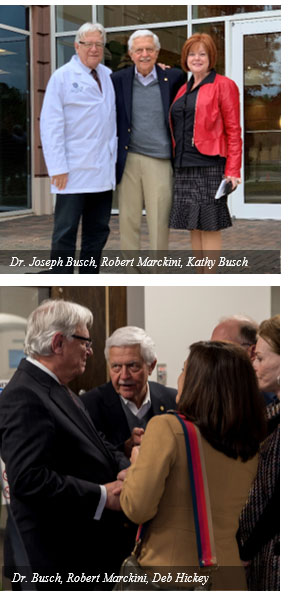 Meeting an MRI Guru
Meeting an MRI Guru
One of the premier practitioners of the 3T mp-MRI in-bore biopsy technique is Dr. Joseph Busch at the Busch Center in Alpharetta, GA. Dr. Busch was trained by the world’s leading experts, Professors Jelle Barenstz, Jurgen Futterer and Anwar Padhani, in Europe; he’s lectured and taught mp-MRI at RSNA, and Johns Hopkins; and is a member of ESUR, International Cancer Imaging Society and RSNA. Dr. Busch uses state-of-the-art, 4th generation 3T mp-MRI in his practice.
In November, Deb and Bob were invited to the grand opening of the Busch Center, just outside of Atlanta, GA. They had the opportunity to spend some time with Dr. Busch and his wife, Kathy, who has been his partner in developing this technology for the past several years. Deb and Bob were impressed with the new facility and astounded by the Busch’s depth of knowledge and experience in this field.
As mentioned earlier, this technology is available only at a few leading-edge medical centers in the world. In our opinion, it’s worth the cost and inconvenience of traveling to a facility that offers this technology for the benefits the patient receives, namely, precise targeting of lesions/tumors within the prostate. The net result is the patient has a much better chance of his cancer being caught early. Additionally, there is a much better chance that the most aggressive cancer will be found with this imaging technique. This information allows doctors to custom design the right treatment protocol for the patient, giving him the best opportunity to have his cancer destroyed.
Clearly, mp-MRI fusion-guided prostate biopsy is light-years ahead of the current, standard TRUS “blind” biopsy, and the new mp-MRI in-bore biopsy is the new state-of-the-art.
Xtandi Approved by FDA for Treating Advanced Prostate Cancer
In December 2019, the U.S. Food and Drug Association approved the Pfizer/Astellas drug, Xtandi for use with patients suffering from metastatic prostate cancer according to a Reuters report.
Xtandi, when used in combination with Androgen Deprivation (hormone) therapy, was shown to reduce the risk of cancer spreading or deaths by 61 percent, compared to patients treated with hormone therapy alone.
This oral medication was previously approved to treat non-metastatic prostate cancer and has been prescribed to more than 420,000 patients worldwide since it was first approved in 2012.
More Metastatic Prostate Cancers Found After Change in Screening Guidelines
In 2011, a report was issued by the U.S. Preventive Service Task Force (USPSTF) recommending against PSA testing because, “there is a moderate or high certainty that the PSA test has no net benefit or that the harms outweigh the benefits.”
 The USPSTF’s feeling was that because prostate cancer is usually slow growing, many men would probably not experience severe pain or death from the disease. Our question was – should the men who would experience severe pain and/or death from prostate cancer be ignored?
The USPSTF’s feeling was that because prostate cancer is usually slow growing, many men would probably not experience severe pain or death from the disease. Our question was – should the men who would experience severe pain and/or death from prostate cancer be ignored?
The USPSTF argued that the consequences from treatment could be significant, including impotence, incontinence, and even death. However, it appeared they considered the consequences of treating with surgery only, and the resulting quality of life issues, when making this determination.
After the report was issued, many doctors complied with the new screening guidelines. Over the past nine years, fewer men were diagnosed with prostate cancer. However, during the same time, there was an increase in the diagnosis of metastatic prostate cancer that would have been found if PSA testing had continued as usual, according to a large study by Kaiser Permanente.
Between 2010 and 2015, PSA-based screening declined 23 percent and biopsy rates declined 64 percent. As a result, prostate cancer detection declined 54 percent. However, during the same time period, metastatic cancer rates increased 37 percent, resulting in 75 more advanced, stage-4 cancers detected.
Our contention has always been that the problem is not the PSA test, it’s what doctors do with the results of the test, which often is over-treating very early stage cancers. Judicious PSA screening, coupled with the latest advanced imaging technology, can help doctors more readily determine which cancers need biopsy and treatment and which cancers don’t.
Note: Bob Marckini goes into much detail on this topic in the second edition of his book.

We’ve been producing BOB Tales newsletters for more than 18 years. During this time there have been important articles that many new members haven’t seen, and some older members may have forgotten. So, we decided to periodically re-run some articles from past newsletters. The following is from August 2005.
Prostate Cancer Awareness – A Personal Observation
We men just don’t get it. It’s truly amazing how many of us in our 50s, 60s and 70s pay so little attention to our health. I frequently embarrass my wife, Pauline, by asking men in this age group if they know their PSA. It’s not so much the asking that bothers Pauline, it’s the fact that it’s usually a stranger, or someone we’ve just met. The answer I receive most of the time, unfortunately is, “What’s PSA?” or, “I can’t remember the last time I had a physical exam.” This is sad. Women are doing an infinitely better job with breast cancer awareness than we men are doing with prostate cancer.
Last month, my friend and BOB member Dr. Terry Wepsic and his wife, Carmy, visited Pauline and me. We had a great visit. Dr. Wepsic is a pathologist and cancer researcher. He has volunteered, along with 39 others, to be on the patient call list, which we share with men who are considering proton treatment. This list gives them an opportunity to speak with others who have been through proton therapy. When men hear that someone with Terry’s credentials has chosen proton treatment, it gets their attention.
Several times during Terry and Carmy’s visit, we were in social situations with men neither of us had met. Without hesitation, Terry would bring up the subject of prostate cancer awareness and ask perfect strangers if they knew their PSA. Not one knew his PSA or if it had been measured in recent years.
How much good we do with this approach is unknown. But at least we get them thinking about it. The “Brotherhood” is at 2,100 members (remember it was August 2005). If each of us encourages one man each month to pay attention to his PSA, that would represent more than 25,000 men each year who would be hearing the message that they need to have annual physicals, and they need to pay attention to their PSA.
Occasionally, someone will say to me, “I don’t know what my PSA is, but my doctor tells me it’s okay.” I don’t know how to say this delicately, but not all doctors fully understand the implications of PSA, family history, PSA velocity, etc. So, it’s up to the patient, in my opinion, to educate himself in these matters, and take responsibility for his own health maintenance. We will be doing articles on this subject in future BOB Tales. In the meantime, why not go out there and ask the question, “Do you know your PSA?”

NAPT 2020: The National Proton Conference
The eighth annual National Proton Conference will be held in Nashville, TN, April 26-29, 2020, at the Renaissance Hotel. Like previous conferences, the National Association for Proton Therapy (NAPT) will provide an outstanding educational program for attendees.
Some topics planned for this year’s event include managing health insurance denials and appeals, flash proton therapy, carbon ion proton therapy, the importance of the proton patient experience, updates in clinical research, and the future of proton therapy.
Deb Hickey plans to attend the conference again this year and will provide a detailed recap in a follow-up BOB Tales.
If you’re interested in attending or learning more about NAPT 2020, email Jamie Miller.

Foods to Help Fight the Common Cold
 According to the Centers for Disease Control and Prevention, adults have an average of two to three colds per year, and this is the time of year that colds are most prevalent. Although washing your hands regularly, getting enough sleep, and keeping your distance from those who are sick are good ways to avoid the common cold, there are also some foods that can help ward off this illness according to WebMD. These include:
According to the Centers for Disease Control and Prevention, adults have an average of two to three colds per year, and this is the time of year that colds are most prevalent. Although washing your hands regularly, getting enough sleep, and keeping your distance from those who are sick are good ways to avoid the common cold, there are also some foods that can help ward off this illness according to WebMD. These include:
Chicken Soup: Studies have shown that chicken soup clears nasal passages and congestion better than other hot liquids.
Citrus: Vitamin C won’t prevent a cold, but it can help you feel better when you have one. Vitamin C from oranges, lemons or limes can help you get rid of the cold faster.
Germ Fighters: Kale, broccoli, cranberries, green tea, red onions and blueberries all have an antioxidant called quercetin with antihistamines and anti-inflammatory properties.
Chili Peppers, which contain capsaicin can help clear out nasal passages and minimize symptoms from a stuffy head.
Ginger helps clear congestion and sooth a sore throat. Try a hot cup of ginger tea.
Avoid caffeine and alcohol. These tend to dry you out just when you need hydration from liquids.
Study: Dairy May be Linked to Prostate Cancer Risk
In a new study published in The Journal of the American Osteopathic Association, Mayo Clinic researchers found that eating a lot of dairy products may be associated with an increased risk of prostate cancer. To perform this study, researchers collected data from 47 existing studies (from 2006-2017), comprising more than 1,000,000 participants, to reach their conclusions. Though the association between eating other animal products and prostate cancer wasn’t as clear – meat diets (including organic meats) showed increased and unchanged risks while plant-based diets appeared to decrease the risk.
Grace Fjeldberg, a dietician at Mayo Clinic Health System in Mankato specializing in oncology nutrition, says dairy products do have some good health benefits and “shouldn’t be avoided like the plague.” Dietitians stress moderation is the key with dairy.
Fjeldberg said the study’s findings generally align with what experts have been recommending for diets – people should eat more plant-based foods, and less processed foods and sugary snacks.

“For it is in giving that we receive.” – Francis of Assisi
As we’ve mentioned, we receive a monthly report of members who’ve made contributions to the Robert Marckini Chair for Proton Therapy Research or Loma Linda University Health’s Vision 2020 campaign, though we don’t know the exact amounts given. December is the time of year we see a marked increase in contributions. We’re still waiting on the report from year end 2019. When we receive it, we’ll be making every attempt to reach out directly to each contributor to express our thanks.
We are sincerely grateful for any and all gifts. Thanks to you, life-saving proton therapy research continues to help those battling prostate cancer, breast cancer, lung cancer, pancreatic cancer, cancers in the brain, skull, spinal cord, eyes, head and neck, and central nervous system. Thanks to you, LLUCC can treat a variety of pediatric conditions, including severe, life-threatening cancers, while minimizing the potentially damaging effects of radiation on developing children. The ongoing research being done at LLUCC also helps those with benign cancers. With the help of the proton beam, damage to healthy cells is minimized allowing patients to not only survive but thrive after treatment.
 Your contributions also help fund clinical research, the foundation upon which successful patient treatment rests. The radiation oncologists at LLUCC conduct ongoing studies to determine new and better ways to use proton therapy, and to make these benefits available to more patients.
Your contributions also help fund clinical research, the foundation upon which successful patient treatment rests. The radiation oncologists at LLUCC conduct ongoing studies to determine new and better ways to use proton therapy, and to make these benefits available to more patients.
This work wouldn’t be possible without the generosity of people like you. Thank you.
Give to Proton Therapy Research
- Donate online.
- Write a check to LLUCC Proton (Put “Marckini Chair” on the memo line) and mail it to LLUH, Office of Philanthropy, P.O. Box 2000, Loma Linda, CA 92354.
- Call Regina Joseph at 909-558-5010.
Give to Vision 2020
- Donate online.
- Write a check to LLUH Vision 2020 and mail it to LLUH, Office of Philanthropy, P.O. Box 2000, Loma Linda, CA 92354.
- Call 909-651-2020.

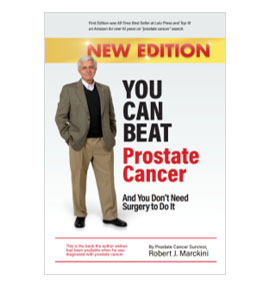 The NEW Book
The NEW Book
By Bob Marckini
While I was working on my first book, I used to daydream about how many people might read it someday. I was hoping it would be hundreds,
maybe even a thousand. An author friend told me that to be considered a New York Times Best Seller, a book would have to sell 10,000 copies.
That milestone was beyond my wildest dreams.
Fast forward 13 years and here are a few statistics:
- You Can Beat Prostate Cancer – And You Don’t Need Surgery to Do It has sold more than 200,000 copies.
- Amazon lists more than 3,000 books on “prostate cancer” and my book has been in their top-10 list (mostly top 5) for the past 11 years. As I type, the book is No. 3 on that list.
- The book has 397 reader reviews, second only to surgery-guru, Dr. Patrick Walsh’s landmark book. It has the highest average (5-Star) rating of any book in the top 50, including Dr. Walsh’s book.
- Lulu.com, where my book is printed handles more than two million titles from authors representing 225 countries and territories. For the past 10 years, You Can Beat Prostate Cancer has been, and continues to be, their No. 1 best seller. Who would have guessed?!
Over the years, 12 proton centers have distributed my book to patients who make inquiries. We know it’s influenced hundreds to choose proton therapy for their prostate cancer and it’s changed lives. How do we know? Because readers have told us so. Hundreds of patients have told us that my book was the reason they chose proton therapy. Nothing could make me happier.
To say that much has changed since the book was first published in 2006 would be an understatement. There has been a “sea change” in prostate cancer diagnostic and imaging technology, PSA testing and understanding, biopsy technology, treatment modalities, and even cancer prevention theory. And there have been exponential changes and developments in proton treatment technology since my first book was published.
Over the past 13 years, I’ve read dozens of books and hundreds of articles/studies on prostate cancer prevention, diagnosis, imaging and treatment. A major source of my education has come from the thousands of emails Deb and I have received from members around the world who’ve come across articles and books on related subjects. I’ve also closely followed the latest developments and improvements in proton therapy and have been blessed to know so many experts in the field, including many of the clinical leaders who have taught me so much. A lot has changed. And, except for the behavior of the private insurance industry, the change has been positive.
So, what’s new in the second edition of my book? Here’s a partial list:
- Latest prostate cancer diagnostic technology;
- “The great PSA testing controversy:” Analysis, compelling evidence, conclusions and recommendations;
- Expanded discussion on pros and cons of all prostate cancer treatment options with emphasis on disease-free survival and side effects;
- The latest developments in proton therapy technology as well as important clinical research showing the superiority of proton therapy;
- Recent research comparing proton to IMRT, including tables showing specific results;
- A review of multiple, independent, comprehensive patient surveys showing overwhelming patient satisfaction with proton therapy with patient-reported results on disease-free survival and toxicity;
- The distressing insurance challenge and reasons for optimism;
- A review of two critically important clinical trials comparing proton to IMRT (PARTIQoL and COMPPARE);
- Impact of diet and lifestyle on prostate cancer prevention and recurrence;
- Significantly improved graphics throughout the book (thanks to my super-talented son-in-law, Deb’s husband, Mark);
- Major revisions to the chapter on The Ten Steps to Taking Control of the Detection and Treatment of Your Prostate Cancer;
- Endorsements by some of the most prominent figures in the proton world and beyond.
The new edition is 120-plus pages longer than the first and, I believe, 10 times more valuable to both patients and doctors.
We are putting the finishing touches on the book, completing the endorsements, adding new patient testimonials and an index. All this should be completed in the coming days and we hope to go to print in February. We also plan to update the Amazon page and Kindle versions.
It's been a lot of work and I’ve received considerable help from many people for which I am grateful. These folks are mentioned in the Acknowledgment section of the book.
I’m excited about the new edition and confident it will be widely accepted. I hope and expect it will increase awareness of prostate cancer prevention and detection. And, mostly, I hope it will increase awareness and acceptance of proton therapy for prostate cancer.
I welcome member feedback on my new book!
Most Recent Amazon Review
Thank you for your review, Roger H.! We’re glad you found the book so helpful.
 Just what I needed! This book is just what I needed – very helpful in understanding the options for prostate cancer treatment during a very stressful time. I start proton therapy in two days. This book not only helped with my decision; Bob also does a great job explaining what to expect. I highly recommend this book.
Just what I needed! This book is just what I needed – very helpful in understanding the options for prostate cancer treatment during a very stressful time. I start proton therapy in two days. This book not only helped with my decision; Bob also does a great job explaining what to expect. I highly recommend this book.
Buy Bob's book online, in bulk, or in Spanish.
Online: Paperback: $19.00--•--Kindle: $7.99--•--NOOK Book: $9.99--•--Apple iBook: $9.99
In Bulk: Conctact us for a discount price list. Proceeds from book sales support proton therapy research through the Robert J. Marckini Endowed Chair at LLUCC.
In Spanish: Buy the print version or in eBook format.
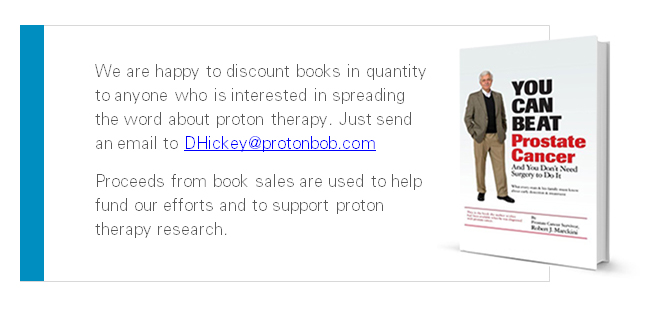

Don’t Abbreviate “2020” When Writing Out the Date, Police Warn
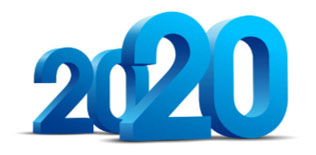 KRON TV in San Francisco reported the following:
KRON TV in San Francisco reported the following:
“We’re only two days into 2020, but authorities have already issued a warning on why you shouldn’t be abbreviating the new year. The warning: Don’t write the date 1/2/20. Instead, write out 2020 in full, so it looks like this: 1/2/2020.
Authorities said the date is easily changeable and could ultimately be used against you. “For example: If you just write 1/1/20, a scammer could easily change it to 1/1/2017 (for instance) and now your signature is on an incorrect document,” wrote auditor Dusty Rhodes.
This process might not, necessarily, be used to steal money from you, but it could be used by scammers who just want to hurt you by nullifying legal documents, as one example.
Useless Facts
- Rubber bands last longer when refrigerated.
- Peanuts are one of the ingredients of dynamite.
- There are 293 ways to make a change for a dollar.
- New Jersey grows two-thirds of the world’s eggplant.
- The longest one-syllable word in the English language is “screeched.”
- No word in the English language rhymes with month, silver or purple.
- “Dreamt” is the only English word that ends in the letters “mt”.
- All 50 states are listed across the top of the Lincoln Memorial on the back of the $5 bill.
- Almonds are members of the peach family.
- Maine is the only state whose name is just one syllable.
- Tigers have striped skin, not just striped fur.
- Honey is the only food that doesn’t spoil.
- A typical pencil can draw a line that’s 35 miles long.
Estate Planning Hints
BOB Member Ron Hendricks is Director, U.S. Foundation for Trinity Western University. He regularly copies us on his “News from Ron” mailings, which are helpful hints on estate planning to the readers of his newsletters. We’ve found Ron’s suggestions to be timely and beneficial. With his permission we periodically share some of his wisdom with our membership. This segment is called …
The Shortest Day – and The Road Less Traveled
The shortest day of the year was December 21. Every day has 24 hours – 1,440 minutes, 86,400 seconds. “For everything there is a season, and a time for every matter under heaven.” Eccl 3:1 (ESV)
Or does it? A short day is coming for all of us – a day when we will not reach the 86,400th second and will graduate to our final reward.
“The Shortest Day” for you may be coming tonight or may be many years into the future. Your opportunity for the satisfaction of legacy that touches many others can be here today, through prayer and proper planning. Don’t wait. Make your appointment with your attorney, financial adviser, tax adviser and gift planner to be sure that your legacy to your family and to God’s Kingdom is secure and your every wish is accomplished.
“Two roads diverged in a wood and I took the one less traveled by, and that has made all the difference.” (Robert Frost) It may seem like the more difficult road to plan your legacy, but this may be one of the wisest things you’ve ever done.
Choice of Road Traveled: We have a choice of two roads in this life: We can follow the popular path or the one less traveled by – which is the right path for you?

Last Month’s Brain Teaser
What do these words have in common?
Aluminum, center, licorice, maneuver, offense, rumor, specialty
Answer: They are all spelled differently in England, which is the source of the American English language: aluminium, centre, liquorice, manoevre, offence, rumour, speciality.
Winner: Wayne Swartz of Uniontown, PA is the Dec/Jan BOB Tales brain teaser winner. Wayne was treated with proton therapy for his prostate cancer 18 years ago! Interestingly, Wayne’s urologist noticed his PSA rising for years, treated him for prostatitis, and performed two (negative) biopsies before Wayne’s PSA hit 10.5. “Then my urologist suddenly closed up shop and left town,” Wayne said.
Wayne wrote a testimonial for our website back in 2003. During that time, he gave us one of our all-time favorite member quotes: “I have not spent one dollar on medicines or follow-up procedures in 14 years post-proton treatment.” That’s one of the best arguments for proton therapy we can think of.
Today Wayne is doing well; his PSA remains low; and he’s still working full-time producing hay for his horses. “I’m glad I did my own research on all treatment options, and I’m glad I found proton therapy and Loma Linda University Cancer Center.”
Wayne plans to donate his signed copy of Bob’s book to his local library. Great idea, Wayne!
New Brain Teaser
This should be easy … but maybe not.
What’s the largest single component of U.S. landfills?
Send your answer to [email protected] for a chance to win a signed copy of Bob Marckini’s second edition book, You Can Beat Prostate Cancer.
Some Chuckles
I got called “pretty” today! … Well, the full statement was actually, “You’re pretty annoying.” But I focus only on the positive.
I fear one day I’ll meet God; he’ll sneeze, and I won’t know what to say.
I’m not here to judge. I’m just pointing out all the mistakes you’re making.
I always knew I’d get old. How fast it happened was a bit of a surprise, though.
I was always taught to respect my elders and I've reached the age when I don’t have anybody to respect.
I have a condition that prevents me from going on a diet – I get hungry.
Apparently, you must eat healthfully more than once to get in shape. This is cruel and unfair.
What Does Love Mean?
A group of adults posed this question to a group of 4- to 8-year-olds, “What does love mean?” The answers they got were broader and deeper than anyone could have imagined. See what you think:
“When my grandmother got arthritis, she couldn’t bend over and paint her toenails anymore. So, my grandfather does it for her all the time, even when his hands got arthritis too. That’s love.” – Rebecca, age 8
“When someone loves you, the way they say your name is different. You just know that your name is safe in their mouth.” – Billy, age 4
“Love is when you go out to eat and give somebody most of your French fries without making them give you any of theirs.” – Chrissy, age 6
“Love is when my mommy makes coffee for my daddy and she takes a sip before giving it to him, to make sure the taste is okay.” – Danny, age 7
“Love is what’s in the room with you at Christmas if you stop opening presents and listen.” – Bobby, age 7 (Wow!)
“If you want to learn to love better, you should start with a friend who you hate,” – Nikka, age 6 (Another wow!)
“Love is when you tell a boy you like his shirt, then he wears it every day.” – Noelle, age 7
“Love is when Mommy gives Daddy the best piece of chicken.” – Elaine, age 5
“Love is when Mommy sees Daddy smelly and sweaty and still says he is handsomer than Robert Redford.” – Chris, age 7
“Love is when your puppy licks your face even after you left him alone all day.” – Mary Ann, age 4
Quote of the Month:
“If there is any kindness I can show, or any good thing I can do to any fellow human being, let me do it now, and not defer or neglect it, as I shall not pass this way again.” – William Penn

The Last Words of Steve Jobs?
People know Steve Jobs for his passion, creativity, and innovation. Many have shared his “final essay” on their social media accounts, but neither his family nor Apple confirm its legitimacy (though they haven’t denied it). With that said, Jobs’ sister mentioned his last words in her eulogy published in The New York Times: “Steve’s final words were ‘OH WOW. OH WOW. OH WOW.’”
Even though no one may ever know if the following essay was, in fact, Jobs’ words, we feel the message is invaluable.
I reached the pinnacle of success in the business world. In some others’ eyes, my life is the epitome of success. However, aside from work, I have little joy. In the end, my wealth is only a fact of life that I am accustomed to. At this moment, lying on my bed and recalling my life, I realize that all the recognition and wealth that I took so much pride in have paled and become meaningless in the face of my death.
You can employ someone to drive the car for you or make money for you, but you can’t have someone bear your sickness for you. Material things lost can be found or replaced. But there is one thing that can never be found when it’s lost – life.
Whichever stage in life you’re in right now, with time, you’ll face the day when the curtain comes down. Treasure love for your family, love for your spouse, love for your friends.
Treat yourself well and cherish others.
As we grow older, and hopefully wiser, we realize that a $300 or a $30 watch both tell the same time. You’ll realize that your true inner happiness doesn’t come from the material things of this world. Whether you fly first class or economy, if the plane goes down - you go down with it.
Therefore, I hope you realize, when you have mates, buddies, old friends, and brothers and sisters who you chat with, laugh with, talk with, sing songs with, talk about north-south-east-west or heaven and earth, that is true happiness!
Don’t educate your children to be rich. Educate them to be happy. So, when they grow up, they’ll know the value of things and not the price.
Eat your food as your medicine, otherwise you’ll have to eat medicine as your food.
The one who loves you will never leave you for another because, even if there are 100 reasons to give up, he or she will find a reason to hold on.
There’s a big difference between a human being and being human. Only a few really understand it.
You are loved when you are born. You will be loved when you die. In between, you must manage!
The six best doctors in the world are sunlight, rest, exercise, diet, self-confidence and friends. Maintain them in all stages and enjoy a healthy life!!
Low PSAs to all,
Bob Marckini and Deb Hickey
To print the BOB Tales newsletter or view the newsletter with a larger font size, click here for the PDF file.
NO MEDICAL ADVICE: Material appearing here represents opinions offered by non-medically-trained laypersons. Comments shown here should NEVER be interpreted as specific medical advice and must be used only as background information when consulting with a qualified medical professional.
